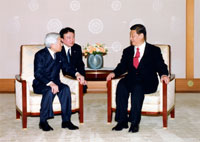The Future of Japan and China – Part 1
DPJ lays groundwork for Chinese invasion

December 2009. Ichiro Ozawa (left) of the DPJ, who visited China with more than 600 people in tow, and President Hu Jintao. Photograph: Jiji
The first point in the Operational Directive is the objective of the second phase: “Establishing an Allied Democratic Party Government in Japan”. Before the Chinese Communist Party can rule Japan, they want a Japanese government to level their way, a government their agents have brought about by secretly manipulating Japanese politicians and media, making it look like Japan did this of its own accord. The concrete tactics they were pursuing to reach their goal were to split up the Liberal Democratic Party (LDP), and combine the powers thus splintered off with that of the opposition party. This is exactly what has led to today’s Democratic Party of Japan (DPJ) Administration in Japan.
So what is happening under the DPJ Administration in Japan?
In December 2009, Ichiro Ozawa, ex-leader of the DPJ, visited China with 143 other Japanese democrats to pay “tribute to diplomacy”. Rules that were in palace were hastily changed to arrange an audience between the Emperor and Chinese Vice-President Xi Jinping. When the Senkaku boat collision incident happened in September 2010, Japan buckled under Chinese pressure and released the captain of the boat. In Tokyo and Niigata, Japanese land is being sold off to China, and in Okinawa, the development of anti-military and anti-U.S. sentiment is being spurred on by the political mismanagement concerning the relocation of the Futenma military base.

The DPJ hurriedly abolished the rule that applications for audiences with the Emperor had to be submitted at least one month in advance, and organized an audience with the Emperor for Chinese Vice-President Xi Jinping (right). Photograph: Reuters/Aflo
In its “Vision for Okinawa 2008”, the DPJ suggested Okinawan independence from Japan and talks about “a large scale reduction of the U.S. military bases”, “introducing the ‘one country, two systems’ policy as a pilot case for stronger regional authority”, and “promoting Chinese and other foreign languages education in primary schools”. It is basically serving Okinawa to China on a silver platter.
Japanese media promote Okinawan independence
Another important point in the Operational Directive is the “Media Directive”, in which China vows “to manipulate Japanese public opinion in a way that creates a fertile breeding ground for the masses to support the installation of an Allied Democratic Party Government”. During the summer 2009 elections, all newspapers and TV channels cheered for a “change of government” which was directly followed by the birth of our present DPJ Government.
The same infiltration of public opinion is taking place in Okinawa, which is becoming China’s gateway to taking over Japan. A “Prefectural Citizen Survey” published on January 1st this year, in the New Year edition of the Ryukyu Shimpo, a major Okinawan newspaper, is a strong symbol of this phenomenon. Among the 30 questions asked, the followings seemed suspicious: “Do you feel uncomfortable with the people of other Japanese prefectures?”, and “Do you harbor positive feelings towards the Emperor and the Imperial Family?”
Another question was “How do you think Okinawa’s position in Japan should develop?” The answer could be selected from choices like: “Okinawa should remain a Japanese prefecture”, “Okinawa should become an autonomous region” and “Okinawa should become independent”. Especially considering Okinawa’s history, it is all the more surprising that its media seem to virtually invite China to occupy Okinawa.
In recent years, the “Map of the Far East 2050” (see the map) was leaked from the Chinese Foreign Ministry that refers to East Japan as “Japan Autonomous Region” and to West Japan as “East Sea Province.” It also caused a stir.
Other than these maneuver activities in Japan, China has started referring to Okinawa as “Chinese territory”, conducted military drills near the median line between Japan and China in the East China Sea, and implemented double digit hikes in its military budget for two successive years. All this makes it more than obvious that China is indeed planning to invade Japan.



















